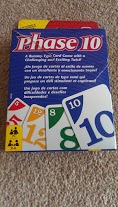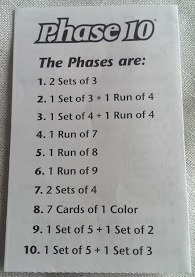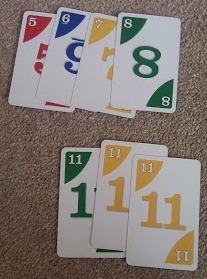So, a Kickstarter project has recently come to my attention, that looks like a perfect game for a family setting.
It's compact, easily transportable, and doesn't require much table space to play, as well as being easily playable by very young children. Interested? I thought you might be!
Welcome to Flippin' Fruit - the fruit rolling, card flipping dice game.
 |
| The contents |
As you can see from the contents, this is a very bright and colourful game - but let's look how it plays.
The game contains 5 12 sided dice. Each dice contains a cartoon like picture of a different fruit - but watch out for Rotten Tom the Tomato!
 |
| The dice |
Here you can see the dice - I love the look of these and again the simple, bold, colourful pictures should certainly appeal to children (and adults!)
As well as dice, the game also comes with three sets of cards - Fruit baskets, Fruit Smoothies and Fruit Salads, but more on these later.
The tube container also acts as a method for rolling the dice. The game takes place over 8 rounds, and on an round each player will have one turn.
The Cards:
There are three types of cards in the game:
Fruit Smoothies
Smoothies are the Green coloured cards that you can see on the right of the picture. These provide 'pips' (or points) - in the example card shown, 2 points are available. Three of these cards are set out at the beginning of the game, and once claimed, the card is yours to keep.
Fruit Salads
Salads are the orange cards shown above - these cards form poker hands - for example, a pair, 3 of a kind, full house etc, and again provide 'pips' for their owner. Unlike the Smoothies, these can be 'stolen' from their owner at any point in the game.
Fruit Baskets
These are the purple cards shown at the bottom of the picture above. Instead of providing 'pips' these cards provide special abilities, and they are claimed in a different way to the other two cards shown.
Gameplay:
A player turn consists of three actions. These actions can be made up of:
- Rolling any fruit dice
- Rolling all Rotten Tomatoes dice
- Taking a Fruit Basket card
Once a player has used 3 actions, they can try to make a Smoothie or a Fruit Salad, by matching dice to the symbols on the cards. If you take a Smoothie card, replace the card with the one on top of the deck. Any dice that have been used, together with any Rotten Tomatoes get returned to the cup. Any dice that were not used, get passed to the next player, and the turn is over.
Rounds 3 and 6 are slightly different - in these two rounds Rotten Tomatoes act as wild cards.
Initial Impressions:
I haven't had a chance to play the physical game yet, however I have had a couple of plays on their Flash version, which seems a decent enough conversion despite not having all the features switched on. It's a simple enough game, that probably takes 10-20 minutes to play, perfect for children who might have shortish attention spans, or for a quick calm game before bed.
I could even see very young children playing this - maybe with a little help (and maybe without the Fruit Basket cards), as the colourful fruits are easy to match. Plus the price of £17 seems reasonable enough.
Status of the Campaign:
At the time of writing, there are 8 days to run on the campaign, and there is just under £200 needed to get this project to happen. There are some interesting looking stretch goals too, so head on over to Kickstarter and get backing!
Further Information:
For more information on the game, check out these following links:


















